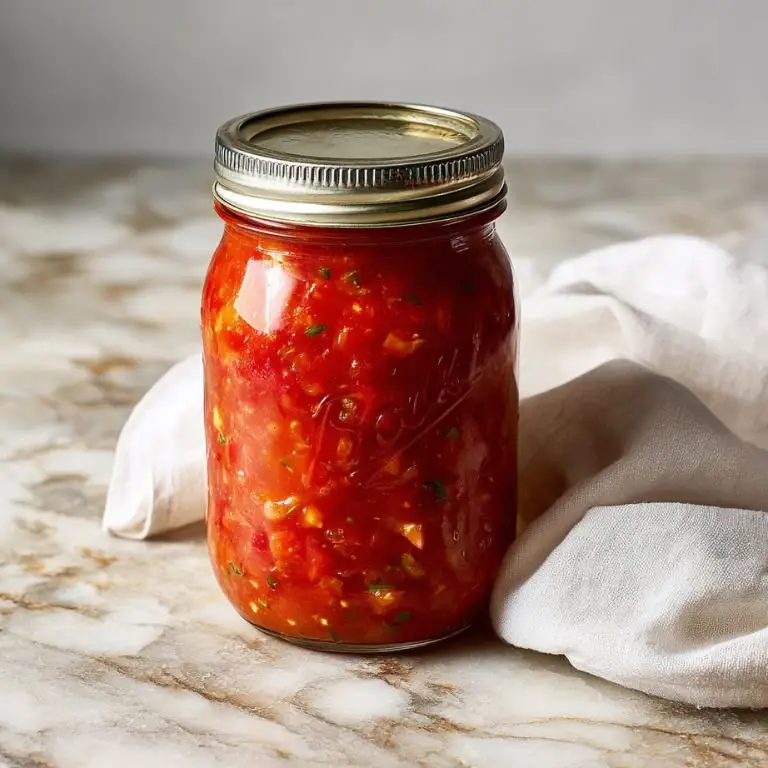Ready to elevate your pantry game? This homemade canned salsa is bursting with sunshine-ripened tomatoes, crisp onions, and vibrant peppers—preserved so you can enjoy restaurant-style flavor year-round. Whether you're planning a fiesta or want a quick dip for movie night, this salsa is full of personality, easy to make, and downright addictive. Think of it as the best salsa recipe ever canning—a blend of comforting tradition and zesty freshness that turns any mundane moment into a celebration.
Homemade Canned Salsa with Tomatoes, Onions, and Peppers
Prep Time 45 minutes mins
Cook Time 25 minutes mins
Canning time per batch + cooling 15 minutes mins
Total Time 1 hour hr 25 minutes mins
Course Appetizer, Condiment, Side Dish
Cuisine Mexican
Servings 6 quarts (about 48 cups)
Large stockpot (8-quart minimum)
Canning pot with rack (water bath canner)
Quart-sized canning jars with lids and bands (6 jars)
Jar lifter & funnel
Ladle & wooden spoon
Clean kitchen towels
Thermometer (optional but helpful)
Fresh produce
- 10 pounds ripe tomatoes Roma or paste tomatoes work beautifully
- 4 medium yellow onions finely diced
- 6 large bell peppers mix of red, green, yellow, seeded and finely chopped
- 4 –6 jalapeños or serranos depending on your heat preference, seeded and minced
- 2 cups tomato juice can be salsa with canned tomatoes if fresh ones are too watery
Acid for safe canning
- 2 cups bottled lime juice or cider vinegar
Flavor enhancers
- 8 cloves garlic minced
- ½ cup fresh cilantro finely chopped
- 2 tbsp kosher salt
- 2 tbsp sugar
- 2 tsp ground cumin
- 1 tsp black pepper
Optional fruity twist
- 1 cup diced pineapple or peach for a fruit salsa flair
Prepare the produce
Bring a large pot of water to a rolling boil. Score the bottom of each tomato with an "X," then blanch 30–60 seconds. Shock in ice water, peel, core, and coarsely crush.
Dice onions, peppers, and chilies. Mince garlic and chop cilantro. If opting for fruit salsa, fold in pineapple or peach now.
Combine and simmer
In your stockpot, stir together crushed tomatoes, onions, peppers, chilies, tomato juice (or canned tomatoes), garlic, lime juice (or vinegar), salt, sugar, cumin, and black pepper.
Bring to a vigorous simmer and let cook 20–25 minutes, stirring occasionally. This reduces excess liquid and blends flavors for that restaurant style salsa for canning vibe.
Sterilize jars
Wash jars and lids in hot, soapy water. Place jars in simmering water (not boiling) for 10 minutes to sterilize.
Keep jars hot until ready to fill. Boil lids separately per manufacturer instructions to activate sealing compound.
Fill jars
Using the jar funnel, ladle hot salsa into jars, leaving ½-inch headspace.
Remove air bubbles (run a non-metal utensil along inside). Wipe rims clean with damp towel.
Center lids and screw on bands until finger‑tight.
Process jars
Place jars into the canner rack, ensuring water is 1–2" above jar tops.
Bring to a gentle boil, process 15 minutes (adjust time for altitude).
With jar lifter, move jars to a towel-lined surface. Let rest 12–24 hours undisturbed.
Seal check & storage
Confirm lids concave and don't flex. Label jars with date.
Store in cool, dark place up to 1 year. Once opened, refrigerate and use within 1–2 weeks.
Ideal Pairings
- Chips & Dips: Serve as a star dips and appetizers option with warm tortilla chips or cheesy quesadillas.
- Toppings: Excellent on tacos, burritos, nachos, stuffed potatoes, or grilled meats.
- Side Dish: Mix with black beans and corn for an impromptu street corn–style salad.
- Sauce base: Use as low-sodium tomato sauce for chili, soups, or shakshuka.
- On breakfast: Spoon over scrambled eggs or breakfast burritos to brighten your morning routine!
FAQs
1. Breast vs. thigh vs. boneless texture
This salsa is vegetarian, but if you plan to add chicken later, boneless thigh yields juicier shreds, while breast stays firmer.
2. Can I use canned tomatoes exclusively?
Absolutely! Substitute all fresh tomatoes with 6 × 28-oz cans of crushed or diced tomatoes—still qualifies as salsa with canned tomatoes.
3. Do I need lime juice and vinegar both?
Use either bottled lime juice or cider vinegar to safely preserve acidity. Only one is required—don’t substitute fresh-squeezed lime if it’s not bottled, as levels can vary.
4. How spicy will it be?
With two jalapeños, it's medium heat. Add more for a fiery kick, or remove seeds to tone it down. Use serranos if you prefer deeper heat.
5. Why is it called ‘restaurant style’?
Because it's chunkier, fresher, and less pureed than supermarket jarred varieties. The textures of onions, peppers, and cilantro stand out, giving it that freshly made, restaurant style salsa for canning vibe.
